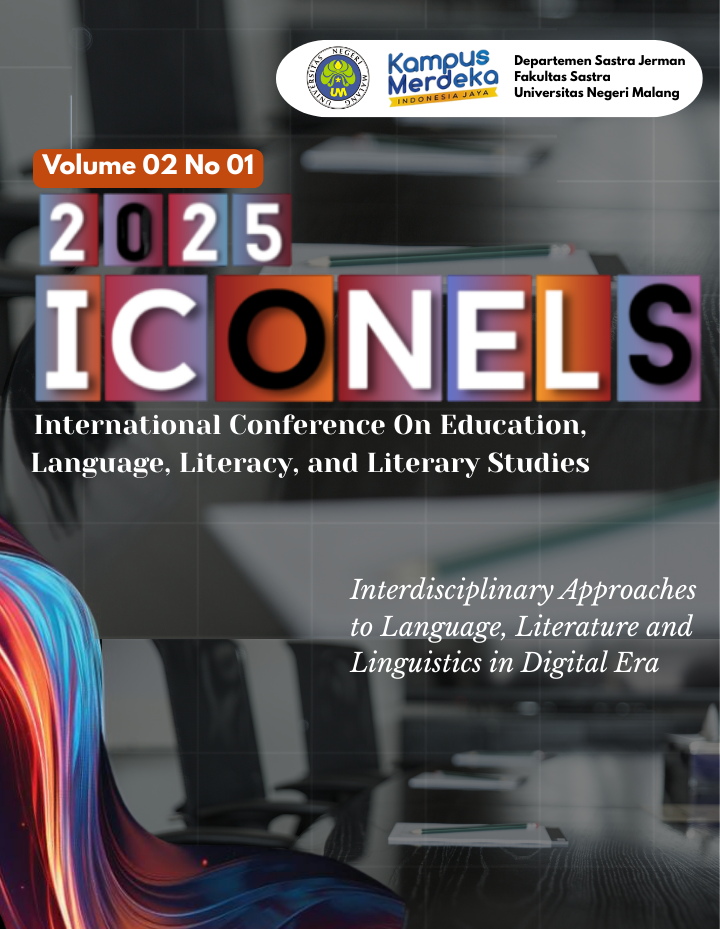Let's Read Media in Indonesian Language Learning to Improve Reading Literacy of Grade 1 Students
DOI:
https://doi.org/10.63011/iconels.v2i1.72Keywords:
Let's Read Media, Reading Literacy, Indonesian Language LearningAbstract
The development of technology has an impact on the use of increasingly advanced media, especially digital media. Media becomes a supporter in literacy learning in elementary schools for grade 1, one of which is Let's read media. This study aims to determine the use of Let's read media in learning Indonesian to improve reading literacy of grade 1 elementary school students. This study is a descriptive qualitative study. The subjects of the study were teachers and grade 1 students at Bulu 03 Pilangkenceng Elementary School. The number of students was 15. Data collection techniques were carried out by performance, tests and observations. The data collection instrument used a reading test to measure students' reading abilities, and an observation sheet to see students' reading literacy activities and learning activities using let's read media. Data analysis used Milles and Huberman which consisted of reduction, presentation and drawing conclusions. The results of the study showed that students' reading performance had a very good category as shown by their appearance and reading skills. The results of the observation showed that students' activity in using let's read media was very high, seen from their activeness and cooperation in compiling stories and notes on titles and readings that they had written. It is hoped that by using the Let's Read media, students will be more active in learning not only in Indonesian language lessons but also other lessons and can be used by other teachers in different classes.
References
Artana, IK (2016). Efforts to foster reading interest in children. Acarya Pustaka, 2 (1), 1–13.
Effendi, D., & Wahidy, A. (2019). Utilization of technology in the learning process towards 21st century learning. Proceedings of the National Seminar of the Postgraduate Program, PGRI University of Palembang.
Farhani, F., Prasetyawan, A., & Widyartono, D. (2022). Parents' Perceptions of the Let's Read Digital Library Application. Journal of Library and Information Studies, 6 (1), 108–123.
Herlina, R., Sutarjo, A., & Hanif, M. (2023). The Effect of Using Let's Read on Improving Elementary School Students' Literacy Skills. Persada Journal, 6 (1), 9–16.
Kern, R. (2000). Literacy and language teaching. Oxford University Press.
Mulyaningtyas, R., & Setyawan, BW (2021). Let'S Read Application as a Reading Aloud Media for Early Childhood. Estetika: Journal of Indonesian Language and Literature Education, 3 (1), 33–46. https://doi.org/10.36379/estetika.v3i1.150
Nurhabibah, N., Habibi, M., Nursalim, N., & Risnawati, R. (2023). Utilization of the Let's Read Application in Improving Reading Literacy of Grade 2 Elementary School Students. Ideas: Journal of Education, Social, and Culture, 9 (1), 155–162.
Sulzby, E. (1985). Children's emergent reading of favorite storybooks: A developmental study. Reading Research Quarterly, 458–481.
Tompkins, G., Campbell, R., Green, D., & Smith, C. (2014). Literacy for the 21st century. Pearson Australia.
Wiryodijoyo, S. (1989). Reading: introductory strategies and techniques. Jakarta: Depdikbud.
Yulianti, Y., & Sidik, U. (2024). Emergent Literacy Learning Strategy in PAUD. Obsesi Journal: Journal of Early Childhood Education, 8 (2), 235–244. https://doi.org/10.31004/obsesi.v8i2.5388
Fitria, Ella. 2020. Let's Read Application: Innovation that Increases Children's Interest in Reading. Accessed February 22, 2025. from https://www.ellafitria.com/2020/06/aplikasi-letsread.html
Downloads
Published
Issue
Section
License
Copyright (c) 2025 Nur Samsiyah, Agung Widyantoro

This work is licensed under a Creative Commons Attribution-NonCommercial-ShareAlike 4.0 International License.



